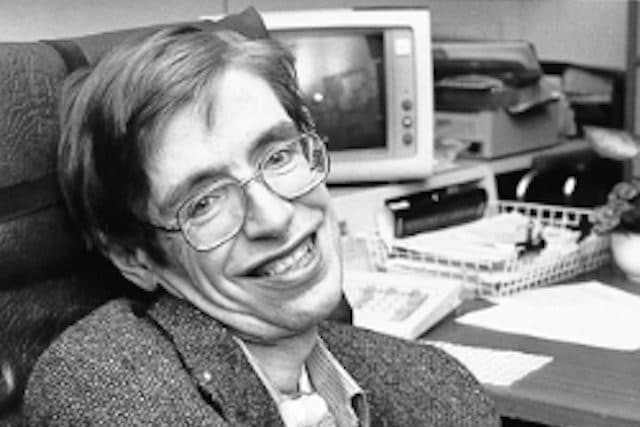The possibility of time travel is often debated and theorized by laymen, but it has also garnered the attention of the titans of physics. Ever since Albert Einstein demonstrated that time dilation is a real thing, speculation has grown about the possibilities of time travel. Einstein’s work illustrated that the faster someone travels, and the closer they get to light speed, the slower time moves for that individual. All the while, time continues to move at the same pace for people on Earth. Stephen Hawking, the world renowned theoretical physicist, did not shy away from the growing speculation about time travel.
10. Champagne Party
https://www.youtube.com/watch?v=742pUDVyTgc
Let’s just say Stephen Hawking was a skeptic when it comes to traveling back in time. To make his point, he conducted a simple, but elegant experiment. He held a party. That’s right, in 2009, Hawking decided to host a party with balloons, hors d’oeuvres, and champagne for guests willing to travel back in time for the party. Hawking told reporters, “I gave a party for time-travelers, but I didn’t send out the invitations until after the party. I sat there a long time, but no one came.”
The Discovery Channel was there to capture the event at the University of Cambridge, in the event that someone happened to arrive. Hawking even made sure to provide precise GPS coordinates, just in case someone became lost through space time.
9. Time Machines

Although Hawking was immensely skeptical of the possibility about traveling back in time, he was willing to engage in the notion. According to Mr. Hawking, everything including time itself has wrinkles and voids in it; there are tiny tunnels in the quantum world that form, disappear, and reappear. Theoretically, they would link separate places and, most importantly for time travelers, time.
However, these wrinkles and voids on the quantum level are far too small for a human to pass through. A time machine that wanted to attempt such a feat would need to capture and enlarge a wormhole enough so that a spaceship could travel through it. If such a device were to built, Hawking said, “One end could be here near Earth, and the other far, far away, near some distant planet.”
8. Time Travel into the Past May Be Impossible

After his theorizations, Hawking concluded that traveling back in time is probably impossible. He believed that the wormhole would create paradoxes that would prevent it from being created in the first place. For example, a person traveling back in time and killing themselves before the creation of the time machine.
More importantly, Hawking argued that natural radiation would seep into the wormhole and the resulting feedback would be so strong that the wormhole, and thus the time machine, would be destroyed. He went even further, suggesting that the creation of such a device may have dire effects. Hawking believed it may trigger a bolt of radiation that would not only destroy the time traveling spaceship, but space time itself.
7. Traveling into the Future

Although Hawking didn’t believing traveling back in time is possible, he did believe that traveling into the future is possible. An example he cites is the Earth’s mass dragging on time. If the Earth was approaching a black hole, time would slow down for people and the force of gravity would increase. Naturally, a black hole is a dangerous method so Hawking proposed the potential of traveling near the speed of light.
As one nears the speed of light, Hawking argued, time would slow down in order to protect the speed, and also to make it physically impossible to ever break it. Therefore, Hawking believed, “that a human traveling near the speed of light could reach the end of the galaxy within their lifetime.”
6. The Spaceship

The fastest manned spaceship was the Apollo 10, and it climbed to a speed of 25,000 mph. In order for time travel to be possible, humans would have to design a spaceship that travels 2,000 times the speed of the Apollo 10. That’s… that’s pretty fast, you guys.
It will also need absurd amounts of fuel to make it through a wormhole while not sacrificing any of its speed. It’s unlikely that even Elon Musk will be able to accomplish this feat in the coming years, but someday it’s certainly a possibility.
5. Paradoxes
Hawking came up with his own paradox named the “Mad Scientist” paradox to further describe the unlikely possibility of traveling into the past. He assured us that he didn’t like the stereotype that scientists are “mad,” but in this case he agrees that the misconception is real.
Suppose that this scientist created a device that would allow himself to travel just one minute into the past, witnessing his alternate self. What would stop this mad scientist from killing his earlier self? Hawking argued that the mere possibility invalidates the fundamental principle of the universe that cause happens before effects. Hawking said, “I think something will always happen that prevents the paradox. Somehow there must be a reason why our scientist will never find himself in a situation where he could shoot himself.”
4. Global Positioning System

Unlike many of his colleagues, Hawking firmly believed that time travel into the future is possible. Hawking noted that Albert Einstein was the first to fully grasp the concept of time and prove that there are places where time slows down and others where it speeds up. As a result of Einstein’s work, Hawking was convinced that traveling into the future was possible.
Hawking suggests that a fuller understanding of Global Positioning System (GPS) is all the proof necessary to conclude that future time travel is possible. A network of satellites orbiting around the Earth make satellite navigation possible. They’ve also revealed that time runs faster in space than on Earth. The satellites contain very precise clocks and yet, “they all gain around a third of a billionth of a second every day.” The system has to correct for the drift, otherwise that tiny difference would upset the whole system, causing every GPS device on Earth to decrease in accuracy by about six miles a day.
Some might suggest that the problem lies with the clocks, but the truth is that they run fast because time itself runs faster in space than on the blue planet below. The Earth’s mass literally drags on time, slowing it down like a stretch in a river. Einstein understood this better than anyone, and Hawking believed that his scientific predecessor proved that time travel into the future is possible.
3. Future Travel Transportation System
Hawking not only gave us hope that time travel is possible, he dreamed up a system of traveling into the future. Science fiction writers take note. Hawking imagined a train track that goes around the Earth. This particular train would need to get as close as possible to the speed of light in order for it to become a time machine. Passengers on this train would have a ticket to the future.
The train would accelerate around the Earth again and again, getting faster and faster each time. As the train gets close to the speed of light, time will start flowing slowly on board, relative to the rest of the world. Hawking predicted everything on the train would go in slow motion. If said train left the station on January 1, 2050 and circled the Earth over and over again for 100 years, before coming to a halt on New Year’s day 2150, it would only feel like a week had gone by for our passengers. They’d leave the train having traveled 100 years into the future.
2. Speed of Light

The biggest obstacle in our way of traveling into the future is manufacturing a vehicle that can travel extremely fast. Not Ferrari fast, or spaceship fast; we’re talking speed of light fast. As mentioned earlier, if a spaceship were constructed it would need to go significantly faster than the Apollo 10, the fastest manned ship on record.
Hawking supposed that based on the ship’s size, it would take awhile to reach the speed necessary for time travel. After one week, according to Hawking, it would reach the outer planets, then after two years it’d reach half-light speed and be outside our solar system. Finally, after two years it would be traveling 90% of the speed of light. That would place the ship’s passengers 30 trillion miles away from Earth, and the ship would finally begin to travel in time. “For every hour of time on the ship, two would pass on Earth.”
1. Stephen Hawking

There are few who did more to make the most obscure and complicated science accessible for those who wanted to learn more about our universe. Stephen Hawking did it all; writing books and creating televisions shows that helped educate the masses.
One of his greatest contributions to his field comes in his expertise on black holes. Hawking made a theoretical prediction that black holes should emit radiation, which is now known as Hawking radiation. His contributions to singularity also cannot be understated, working on several groundbreaking theorems. Hawking was a titan in his field, and there’s been no greater voice in understanding the cosmos, and man’s place in it.